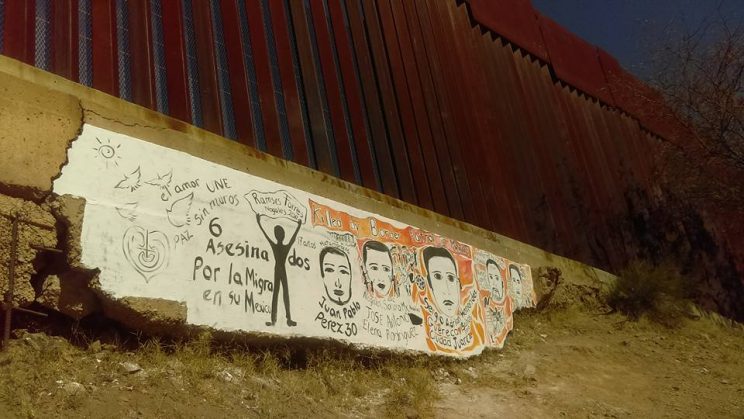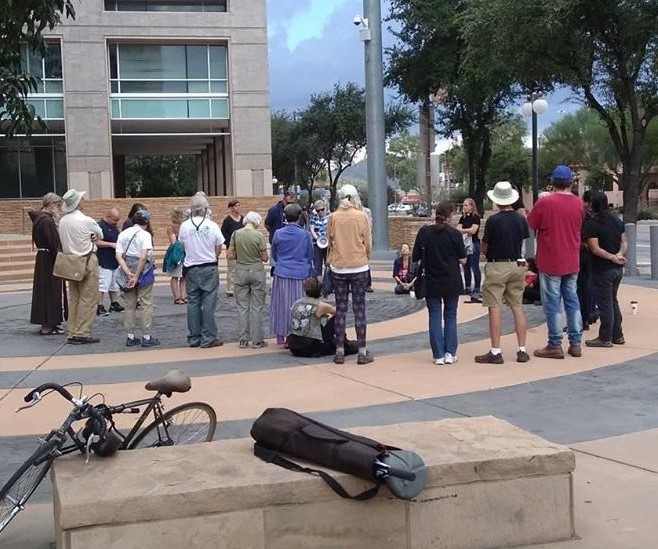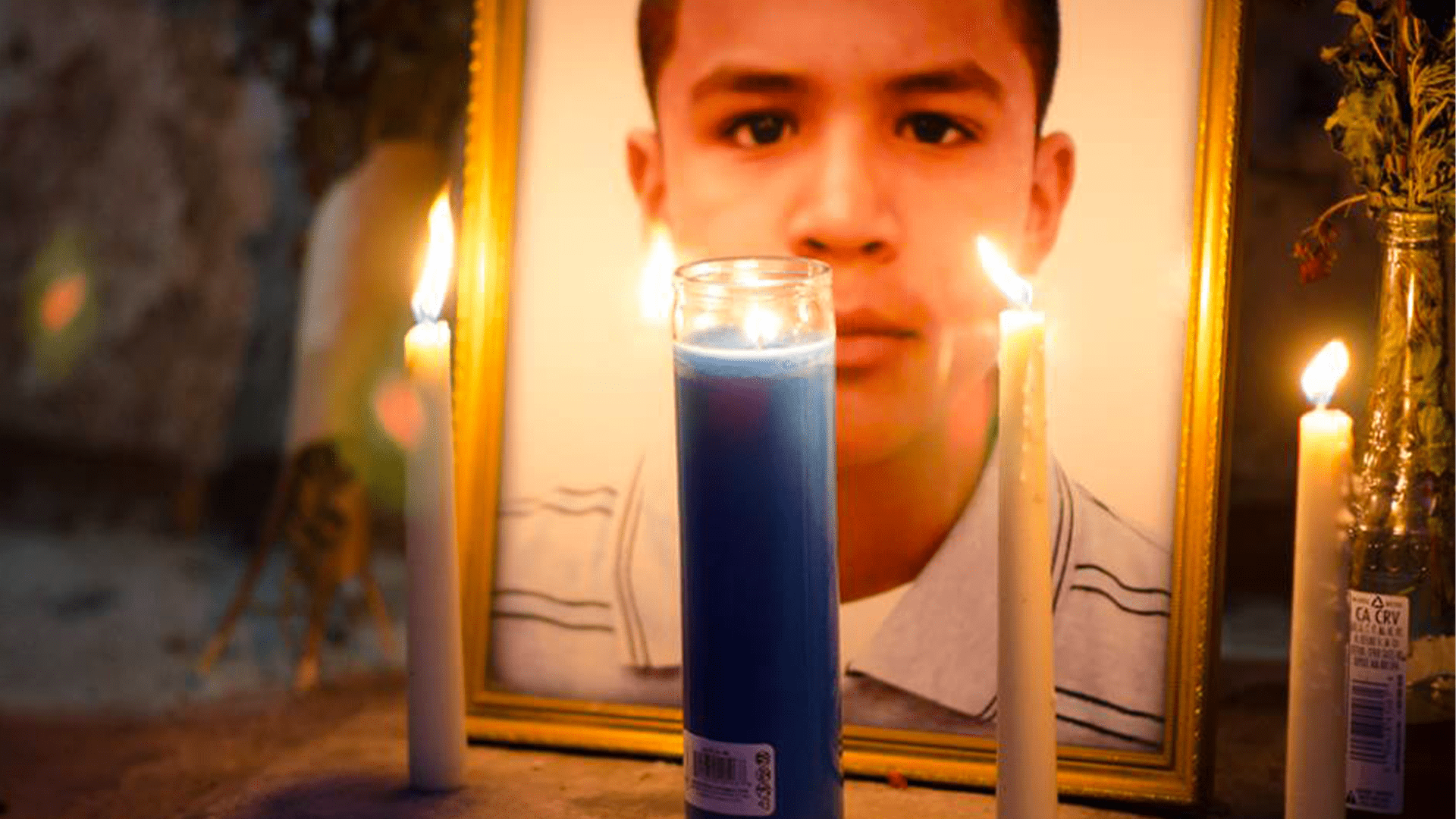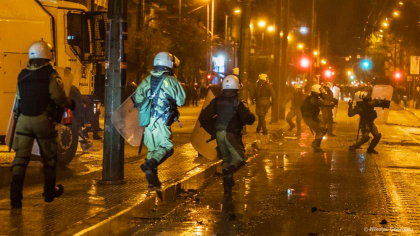Border Patrol Agent Back on Trial for Cross-Border Killing of Teenager
Tucson, AZ – Border Patrol agent Lonnie Swartz is being retried in court for the 2012 cross-border killing of 16-year-old José Antonio Elena Rodriguez. In April 2018, Swartz was found not guilty of second degree murder with hung jury on lesser charges of manslaughter. A second trial of Swartz on these charges has recently ended with the verdict now in the jury’s hands.
Updated Coverage: Verdict in Trial of Border Police Murder to be Announced This Week (Nov. 19, 2018) and Not Guilty: A Precedent of No Accountability in Border Patrol Shootings (Nov. 22, 2018)
At approximately 11: 30 pm on October 10, 2012, José Antonio Elena Rodriguez was in his home neighborhood of La Capilla in Nogales, Mexico when Swartz shot 16 times through the fence, striking José Antonio with ten bullets in the back, back of head, and arm. The Border Patrol (BP) argue that Swartz was defending himself from rocks being thrown over the cliff and wall.

Rodriguez’ family and supporters argued that the trial in April withheld important evidence, and the retrial has been biased in favor of the lawyers representing the Border Patrol Union. In addition to the criminal proceedings there is an open case in civil court, in which the ACLU is representing José Antonio’s family and seeking financial damages.
Jury Selection
Throughout the jury selection process the defense was permitted to exclude 12-13 potential jurors, and the prosecution was permitted to exclude 8-9. The jury pool was asked if any loved ones or friends had histories of smuggling or drugs, to describe their relationship to the border, and if they had talked to people about border issues. Other questions included whether anyone had ever been the subject of a secondary search, whether anyone spoke Spanish, and if jurors happened to be law enforcement officers and whether they had been the victims of assault while on duty.
In one notable question, Judge Raner C. Collins asked whether any jurors were members of a group that advocated for the enforcement or non-enforcement of any particular law, “such as the NRA or the humanitarian aid group No More Deaths.” Jurors were also asked to list any bumper stickers they had on their cars. The first potential juror to be excused after this final question was a Mexican-American female attorney who shared that she had a bumper sticker of a Mexican girl wearing a big sombrero on her car.
Opening Statements
The opening statements made by the prosecution were general in nature, focusing on inappropriate use of lethal force by Swartz, while the defense laid out their entire case based on portraying José Antonio as a cartel member and casting his neighborhood in Mexico as a high-crime area. Assistant U.S. Attorney Mary Sue Feldmeier relied on the Border Patrol narrative of the events, which claim that José Antonio was shot because he was participating in a drug smuggling operation by throwing rocks.
The prosecution’s two central arguments against BP agent Swartz are first, that the rocks did not justify use of lethal force, and second, that Swartz continued shooting at José Antonio after he was no longer a threat – because the bullet that killed him hit after he was already on the ground. The defense stated that Swartz was protecting other Border Patrol agents from imminent harm.
Neither the prosecution nor the defense challenged the assumption that José Antonio was throwing rocks. This focuses the trial on the specific actions of Swartz, and excludes the option of using this trial to bring witnesses to testify about the culture of abusive behavior in the agency.
The prosecution is conceding a point in court that other U.S. government actors in this case have previously challenged due to the height differential between the US and Mexican side, including the former head of the Internal Affairs at the Customs and Border Protection, James Tomsheck.
“It’s abundantly clear,’’ Tomsheck, who eventually visited the site with the F.B.I., told the court, ‘‘that there was no potential for José Antonio to have thrown any projectile from where he stood when he was shot that could cause injury on the U.S. side of the border, not even if he were a major-league baseball pitcher.’’
The prosecution opened with a line of argument that emphasized that Swartz fired on José Antonio because he was “fed up with rocking.” Assistant U.S. Attorney Wallace Kleindienst argued that the shooting was unjustified because there was not justifiable fear that the rocks could cause grievous harm – the protocol Border Patrol sets as justifiable use of lethal force.
The prosecution described the sequence of events that night: other border patrol officers were on the scene without weapons drawn or expressing fear of rocks, and Swartz arrived to the scene shortly after with his weapon drawn and immediately approached the wall, firing 16 shots from three locations on the fence.
Kleindienst went on to describe that those shots hit José Antonio 10 times, all in the back. José fell to the ground after the first shot and Swartz continued to fire, moving twice to get a better shot and reloading to continue firing.
In his opening statement, Swartz’s lead defense attorney, Sean Chapman, retained by the Border Patrol Union, stressed that rock throwing put the officers in danger. Rock throwing is frequently cited as reason for BP use of force, however during Swartz’ tenure at the Nogales station, no Border Patrol agent have ever been injured by a rock.
Chapman argued that José Antonio was part of a smuggling operation, because of rust found on his shoes and based on testimony from an FBI informant in Mexico identified only by nickname as Señor. Señor was paid $243,000 by the U.S. government for information in the past, and claimed that other rock throwers told him José Antonio was part of the operation.
Repression of Protest of the Trial
In the first week of trial, which began on October 23, Judge Collins threatened to rule a mistrial if protests about the case continued. Collins referred to a vigil organized the first day of the trial as a “kerfuffle.”

Judge Collins, who is overseeing this trial, has a history of involvement with high profile political trials from the border. He was the judge of the court cases of No More Deaths activists in 2005, in relation to their humanitarian aid work in Southern Arizona, and is assigned to the case of another humanitarian aid volunteer Scott Warren.
On the day of jury selection, the court would not allow supporters of José Antonio’s family to enter the building. After repeatedly arguing with the guards that it is a public trial, and jury selection is among the most important aspects of a trial, supporters were allowed inside but told they would simply be turned away at the courtroom. In the courtroom, federal marshals said that the room would be full, and summarily turned members of the public away. One community organizer, Zack Forman, a law student at University of Arizona, responded by asking the location of the overflow room, as this was a critical stage in a public trial. Marshals responded that the “fishbowl” was downstairs.
The doors to the “fishbowl” were blocked by armed homeland security police outfitted with full tactical gear. Family and exclusively credentialed press ended up being allowed into the overflow room, without the court interpretation system usually offered to the Spanish-speaking family, they could only listen to proceeding only in English. Indeed, because of the technological arrangements in the room, the family could not even view the jurors during selection. The ACLU in Tucson later reported that even several members of the press without court approved press-badges, including freelancers, were turned away from this observation room.
Law-trained members of the community were stunned that the court was attempting to block the public from accessing this stage of the trial altogether. Most people who were turned away simply left.
After insistent exchanges with the marshals, and one person being escorted out of the building for attempting to film the interaction, Collins allowed only 5 people (not including the family), to enter the courtroom for jury selection. Despite this strict limit, Art del Cueto, the vice president of the local Border Patrol union, was promptly seated when he arrived late.
The indictment of Lonnie Swartz is the first criminal indictment of a Border Patrol officer for murder since BP agent Nicholas Corbett was tried twice in 2007; both trials ended with hung juries. According to The Guardian, there were 97 murders by Border Patrol agents between 2003 and Spring of 2018. This includes 6 victims killed while in Mexico, according to the Border Patrol Victims Network, as well as the high profile murders of 20-year-old Claudia Patricia Gómez Gonzáles and 16-year-old Cruz Velazquez who was forced by BP to drink a lethal amount of liquid methamphetamine.
This case echos the rallying cry heard across the United States during the high profile prosecutions of police officers for the killings of black people, with community members insisting that law enforcement cannot be trusted to police themselves. Local advocates compared the prosecution of Lonnie Swartz by federal prosecutors to the left hand prosecuting the right hand.
Activist Eduardo Garcia says that the result of this trial is historic because it could not only deliver justice for Jose Antonio, but would set a precedent of actual legal consequences for Border Patrol brutality: “This case should be a breaking point for all the people trying to work on the intersections of border militarization, and police brutality.”
‘The Left Hand Prosecuting the Right’
For years, border communities have experienced the impacts of the lack of accountability, or oversight, that has enabled Border Patrol agents to abuse their authority and kill with impunity. Long time community member Isabel Garcia, a retired Tucson public defender, described the structural challenge posed by the fact that federal prosecutors work everyday with BP and yet are in this case responsible for holding a Border Patrol agent accountable.
The federal courthouse in Tucson, Arizona has a history of unconstitutional prosecution of latinx migrants and community members. Immigration offenses make up a large amount of the federal caseload (30% in 2015). The criminal justice system relies on coerced pleas to lessen that burden. Monday through Friday, 75-people are tried in daily, expedited trials through Operation Streamline, which relies on fast-track programs that offers lower charges in exchange for early guilty pleas. This courthouse and prosecutor’s office is the only avenue for criminal legal redress within the U.S. justice system available to the family of José Antonio.
What makes this case so exceptional is that there has been a trial at all. In the two years between José Antonio’s death, his mother Araceli and grandmother Taide fought for prosecution, winning an indictment in 2014. Taide has lived for decades in Nogales, Arizona to work as domestic worker while her family lives just across the fence in Nogales, Mexico. Since Jose’s killing, it has been an uphill battle for the family to get the case into court.
Taide’s employer was lawyer Roberto Montiel, who served as a Superior Court judge in Arizona for over two decades. He and his partner played a key role by using their connection to Mexican police and US Department of Justice to pass information between the two to lay the beginnings of the case.
Chapman told the jury in the beginning of the Swartz trial that the Border Patrol is a military organization charged with enforcing immigration and narcotics laws: “They are not like us. They have a dangerous job.”
The Border Patrol Union has been widely criticized of taking far-right wing positions, recently they endorsed an extremist video that “draws a correlation between gang rapes, Islam, and immigration.” The union was also one of the first law enforcement groups to endorse Donald Trump’s campaign for President.
After 9/11 and the creation of the Department of Homeland Security in 2002, the number of agents doubled over the next decade. This had followed the acceleration of border militarization with Operation Gatekeeper that was a response to the large numbers of Mexican farmers displaced by the NAFTA free trade agreement. During this rapid expansion of the Border Patrol, it became more closely associated with military agencies; veterans make up more than a quarter of BP agents.
James Tomsheck called the killing of José Antonio the most egregious example of any excessive force case he’d seen at CBP, and said there was no evidence that the teen had been throwing rocks. In 2017, Tomsheck told The Nation that:
“There are memos that I have seen that remain at CBP…that strongly encouraged agents to use lethal force when responding to rock-throwing incidents that they believe put their life at risk. [Those memos] flew in the face of the common sense response to projectiles being thrown, which is step out of the path of the projectile, or duck. I spent over 40 years in law enforcement. I started as a police officer in Omaha. We didn’t get rocked a lot, but we had lots of bricks and bottles thrown at us. The reality is that no one ever gave any consideration to using lethal force.” – James Tomsheck
In June of 2014 (Swartz was indicted in October of the following year) Tomsheck was issued a so-called ‘3R’ letter (which stands for reassignment, resign, or retire) and he choose to retire.
At the foundation of the trial is the intersection of multiple narratives plaguing the borderlands. José Antonio’s family and supporters argue there are inconsistencies and fundamental biases at play in the case. The focus on stone throwing is frequently used to justify deadly use of force along the border. The federal government has been unwilling to fully prosecute Lonnie Swartz, as is often seen in attempts to prosecute killer cops across the country. The court is also allowing lots of time to be spent on debating the implications of the role of drug smuggling in the neighborhood which is related to the impact of the war on drugs in border communities. Further, the militarization of the border has increased the local presence of the Border Patrol, which was described by Chapman in the opening statement as a paramilitary organization.
This trial provides an important public representation of the policies of Border Patrol enforcement and directly reflects the legacies of ongoing militarization of the borderlands, colonialism, and racism.
Extended coverage: Verdict in Trial of Border Police Murder to be Announced This Week and Not Guilty: A Precedent of No Accountability in Border Patrol Shootings (Nov. 22, 2018)
Continue to follow Unicorn Riot for more updates on this case as well as further reports from the border, as we have a small media team near Tijuana to bring context to the many issues that migrants and the population of the border regions face.
Watch our 2017 special ‘Crisis: Borderlands‘, which chronicles the ongoing border crisis and also how humanitarian groups have stepped up to help, only to get hindered by the Border Patrol, who dump water and destroy food supplies left in the desert for migrant travelers.
Crisis: Borderlands from Unicorn Riot on Vimeo.
Cover image via Border Patrol Victims Network.
Please consider a tax-deductible donation to help sustain our horizontally-organized, non-profit media organization:



